PRUNING FOR BEAUTY, FUN, AND FLAVOR
Yew Love
Mundane as she may be, I love yew (not mispelled, but the common name for Taxus species, incidentally vocalized just like “you”). Hardy, green year ‘round, long-lived, and available in many shapes and sizes, what’s not to love? Perhaps that it’s so commonly planted, pruned in dot-dash designs to grace the foundations in front of so many homes.
Still, I love her. For one thing, Robin Hood’s bow was fashioned from a yew branch (English yew, T. baccata, in this case). Two other species — Pacific yew (T. brevifolia) and Canadian yew (T. canadensis) — are sources of taxol, and anti-cancer drug.
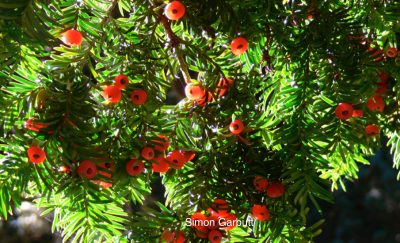
At a very young age, I became intimate with yew bushes surrounding our home’s front stoop, on which my brother and I would often play. Yew’s red berries, with an exposed dark seed in each of their centers, would give the effect of being stared at by so many eyes. Sometimes we’d squish out the red juice, carefully though, because we were repeatedly reminded that all parts of the plant are poisonous. (I’ve since learned that the red berries are not poisonous; but other parts of the plant, including the seed within each red berry are poisonous.)
If yew has, for me, one major fault, it’s that deer eat it like candy. Interesting, since grazing on yew can kill a cow or a horse.
Mostly, I love yew because she takes to any and all types of pruning. My father once had a very overgrown yew hedge threatening to envelope his terrace. I suggested cutting the whole hedge down to stumps. Following an anxious few weeks when I thought my suggestion perhaps overly bold, green sprouts began to appear along the stump. A few years later the hedge was dense with leaves, and within bounds.
Although usually pruned as a bush, yew can be pruned as a tree. A trunk, once exposed and developed, has a pretty, reddish color. Deer sometimes take care of this job, chomping off all the stems they can reach to create a high-headed plant with a clear trunk.
As an alternative to being pruned to dot-dash spheres and boxes, yew hedges can be pruned to fanciful shapes, including animals, or “cloud pruned” (niwaki, the Japanese method of pruning to cloud shapes). Many years ago, I followed the herd and planted some yews along the front foundation of my house, pruning them to one long dash. No dots.
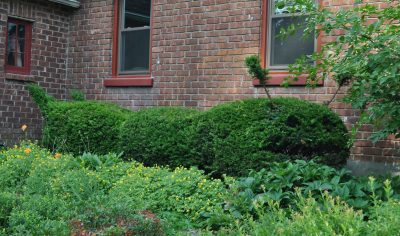
Since then, I’ve converted that hedge to a giant caterpillar and, more recently, tired of the caterpillar and attempted to cloud prune it, not with great success so far. (It’s my shortcoming as a sculptor, not the plant’s fault.) The goal in this case is not the kind of cloud pruning with clouds as balls of greenery perched on the ends of stems. My goal is to blend the four plants together as one billowy, soft cloud.
Facing my kitchen window is another yew, a large one that was planted way before I got here. Its previous caretaker, and up to recently I, have maintained it as a large, rounded cone. Last year I decided to make that rounded cone more interesting, copying a topiary in Britain. The design is in its early stages, awaiting some new growth this year to fill in bare stems now showing in interior of the bush.
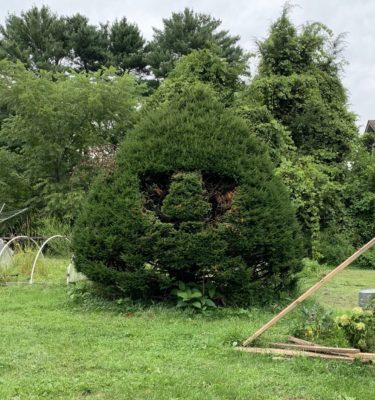
Not Too Late for Peaches
Moving on to more pragmatic pruning . . . peaches. No, it’s not too late. In fact, the ideal time to prune a peach tree is around bloom time, when healing is quick. This limits the chance of stem diseases, to which peaches are susceptible.
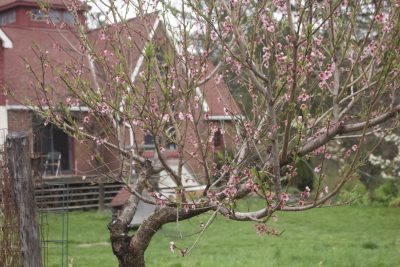
Peach tree, before pruning
Peach trees need to be pruned more severely than other fruit trees. As with other fruit trees, the goals are to avoid branch congestion so remaining branches can be bathed in light and air, to plan for future harvests, and to reduce the crop — yes, you read that right — so that more energy and better quality can be pumped into remaining fruits.
To begin, I approached my tree, loppers and pruning saw in hand, for some 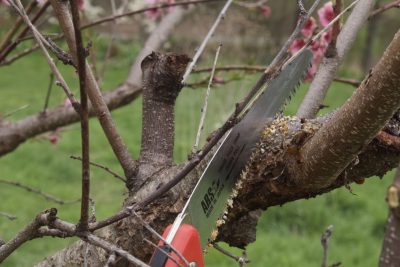 major cuts aimed at keeping the tree open to light and air.
major cuts aimed at keeping the tree open to light and air.
Peaches bear each season’s fruits on stems that grew the previous season. So next, with pruning shears, possibly the lopper, in hand, I went over the tree and shortened some stems. This coaxes buds along those stems to grow into new stems on which to hang next year’s peaches.

And finally, I went over the tree with pruning shears, clipping off dead twigs as well as weak, downward growing stems. They can’t support large, juicy, sweet fruits.
Done. I stepped back and admired my work.
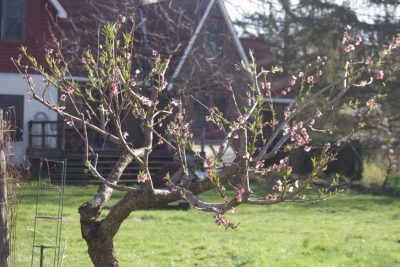 And, of course, for more about pruning, there’s my book, The Pruning Book.
And, of course, for more about pruning, there’s my book, The Pruning Book.


Do you have bees???? Honey bees (do you have a hive or are they from elsewhere???) or native bees???? Or how do your plants get fertilized???
I had bees a long time ago; not now. Pollination never seems to be a problem here. There are plenty of wild honeybees as well as other bees. Perhaps it’s the diversity of wild and cultivated plants and the lack of pesticides.
I too have long loved yew. Once I have a perimeter fence to keep out the deer (slated for 2022) I plan a yew hedge to enclose the back yard on a larger piece of property. Unfortunately I have been disappointed to find that not only here in Maryland (zone 7A) but in the whole country getting T. baccata seems impossible. Do you have a recommendation for good alternative for a clipped hedge (or a source for English yew)? I plan so-called Irish yews for elsewhere on the property, and these are easy to find, but obviously not good for hedging.
I can’t imagine why those yews would be so hard to find. If you can locate one somewhere, they’re pretty easy to propagate from cuttings.
Wondering if you have had any success propagating peach trees by cuttings or some other means? Any tips would be appreciated.
Yes, I have propagated peach trees from cuttings, a long time ago. I can’t remember if they were hardwood or softwood cuttings, though.
Great post! And the peach looks amazing. I am always struggling with people I
advise about the needs of fruit trees. The beginners. Hardly anyone wants to
prune. They seem to feel it is harming the tree!
I do have yew hedges on this property, and I have added some others just because
they make a nice evergreen foundation for the landscape gardens. They are tough as nails! The hedge is decades old and has been hard pruned. Took 2 full season but came back really well. This year I am beginning (6+ years later) to shape those that I planted. It’s fun. I never knew that
yew are so poisonous to most animals. The interesting facts you included in the posts are so welcome.
As for that caterpillar, yew’ve got to be kidding.
Good one!
My husband was wondering if it’s possible to prune our peach trees AFTER they flower, or after they have been flowering for a little while. He doesn’t want to take food from the bees! I say, prune them when you say and put the cuttings in a pot outside. The bees won’t know the difference. He thinks it’s not the same. We will defer to your wisdom and remain happily married.
You’re both right, except that after the trees have been flowering for awhile the flowers start to senesce so their pollen is probably not appealing to bees anymore.
We watched a dvr’d episode of last night which featured you and your farmden and today have been reading your site voraciously – just ordered your Landscaping With Fruit, next will be Pruning and anxiously awaiting copies of the Uncommon Fruits to become available.
Do you have any advice for helping an old (50 year +) apple tree that was butchered instead of pruned? We live on a mountain slope at 4,000 feet that was an apple orchard until the late 70s. The “tree care” company men we hired in February to remove 9 dead trees from our woods and prune 4 old apple trees on the edges of the pasture (part of the old orchard) took a short cut (literally) with the last tree, as it had started snowing heavily. Instead of pruning, they just cut the top 1/2 of the tree off (the tree was at least 35 feet tall). When the snow cleared and we saw what they had done I literally cried. It looks exactly as you would imagine- stumps on top and the top branches left much longer than the lower ones. On a hopefully positive note, it flowered heavily and has begun leafing out.
Our county extension office advised we not try to correct anything until next winter’s dormancy, but I am concerned about one large branch from near the top that now hangs almost to the ground. Should we shorten it or hope it hangs in there til winter? Fertilize this year or not? (I have read both yea and nay).
To further lengthen this epic, deer and bear LOVE the apples on this one- the deer stand on their hind legs to reach them, the bears just climb it – fingers crossed they don’t break even more of it.
I apologize for the length and thank you for a wonderfully informative site!
Shortening the branch, or any pruning, will not kill the tree. The main concern is sunburn on the once-shaded branches. Also, expect a lot of watersprouts. I would cut some of the topped branches back to their origins, just some of them. It’s unlikely the tree needs fertilizer.
Thank you – will do just as you suggested. Glad the tree will make it through this blubder6.
Lee, do you think peach trees will ever be grown on dwarfing rootstock and be long lived like apples are now? I’ve grown peach trees but they usually don’t live for more than 10 years and then you have to contend with the stump.
Probably not. I think that irrespective of rootstock, peach wood is not very long-lived, probably in part because they’re not really well-adapted to winter weather of fluctuating temperatures.